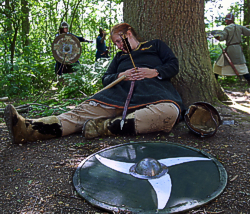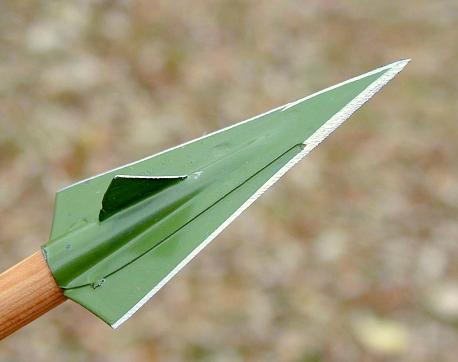Malik
 Auror
Auror
About armor: I don't know. I have never shot a person in armor. (For that matter, I've never shot a human being with an arrow. Maybe there's something in human anatomy that automatically stops arrows and I'm way off base on all this.)
My gut tells me that once you got penetration of the armor, the arrow will keep going, and you're going to get a pass-through or at least massive penetration. Bodies are soft and squishy; there's not much resistance there.
There are so many types of armor that I just couldn't give a definitive answer. Thinking it through, though:
You won't get a pass-through on a 15th-Century field harness. Even if you penetrated the iron, the drag on the shaft from the sides of the hole would slow the arrow down. That's a no-brainer.
I'd think that mail wouldn't slow the arrow down enough to stop it, but the leather and felt beneath might prevent a complete pass-through. Some arrowheads were specifically built to defeat armor, of course, and this is what you'd want to use, but that initial shock as the arrowhead breaks the mail rings would burn up some of the kinetic energy, similar to a round shattering a ceramic bodyplate in modern bodyarmor. That coupled with the drag from the layers beneath the mail might slow the arrow down. It might.
Also, arrows spin, and when you stab a sword into riveted mail the links twist up and trap the blade. You never hear about that in fantasy novels, either, but that's physics. If you want to talk about that phenomenon, start another thread.
I've seen arrows hit hardwood trees and explode, leaving the heads buried in the trunk. I have to wonder if, given just the right amount of armor, this would be reproducible. You'd have a hell of a time getting the arrowhead out of the body. Ick.
Your best defense against an arrow is armor in layers, to strip the energy away. A coat of plates (I might be the only fantasy writer whose characters use a coat of plates, though), over mail, over a suede tabard, over a felt jerkin, over a linen arming jack. Even then, I wouldn't want to get shot with an arrow. No way. I'd be watching for archers every waking moment.
My gut tells me that once you got penetration of the armor, the arrow will keep going, and you're going to get a pass-through or at least massive penetration. Bodies are soft and squishy; there's not much resistance there.
There are so many types of armor that I just couldn't give a definitive answer. Thinking it through, though:
You won't get a pass-through on a 15th-Century field harness. Even if you penetrated the iron, the drag on the shaft from the sides of the hole would slow the arrow down. That's a no-brainer.
I'd think that mail wouldn't slow the arrow down enough to stop it, but the leather and felt beneath might prevent a complete pass-through. Some arrowheads were specifically built to defeat armor, of course, and this is what you'd want to use, but that initial shock as the arrowhead breaks the mail rings would burn up some of the kinetic energy, similar to a round shattering a ceramic bodyplate in modern bodyarmor. That coupled with the drag from the layers beneath the mail might slow the arrow down. It might.
Also, arrows spin, and when you stab a sword into riveted mail the links twist up and trap the blade. You never hear about that in fantasy novels, either, but that's physics. If you want to talk about that phenomenon, start another thread.
I've seen arrows hit hardwood trees and explode, leaving the heads buried in the trunk. I have to wonder if, given just the right amount of armor, this would be reproducible. You'd have a hell of a time getting the arrowhead out of the body. Ick.
Your best defense against an arrow is armor in layers, to strip the energy away. A coat of plates (I might be the only fantasy writer whose characters use a coat of plates, though), over mail, over a suede tabard, over a felt jerkin, over a linen arming jack. Even then, I wouldn't want to get shot with an arrow. No way. I'd be watching for archers every waking moment.

 Myth Weaver
Myth Weaver

 Minstrel
Minstrel
